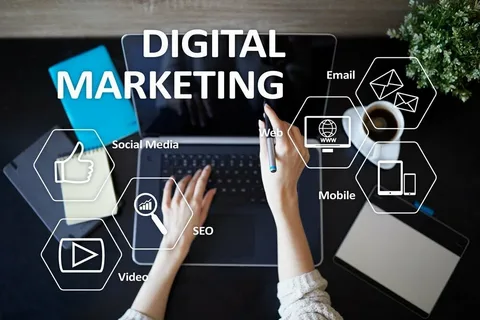Ultimate Guide for Digital Marketing Strategies
Digital marketing is a crucial aspect of any business model used by organizations today. The world has gone online and any company that aims to sell its product must ensure it adopts various online platforms to target its audience. Any promotional campaigns are also part of digital marketing which include social media marketing, SEO, content marketing, and paid advertises.
The detailed information in this guide from Digital Marketing UK presents the most useful tools that may be used to make a business successful within the digital marketing environment.
Search Engine Optimization (SEO)
Search engine optimization commonly known as SEO is among one of the most strategic components of online advertising. It means the process of enhancing a website to rank higher on the search engine result pages (SERPs). The higher the position of the site is, the more people is likely to see it and possibly become its customer. Key SEO practices include:
Keyword Research: Knowing what specific keywords and phrases your audience is looking for when finding information on your website.
On-page SEO: Elements including title tags, meta descriptions, and headers and main content.
Off-page SEO: Creating a linkage from quality to domain development and increase in its authority.
Technical SEO: Make sure your site is well optimized technically, which means it is fast and mobile friendly with protected, secure HTTPs connections.
Content Marketing
Content marketing is all about creating high-quality content that will interest a target audience in a business. These could be in areas such as and blog articles, vlogs, drawings, e-Books, e-White papers, and success stories. This makes it easier to inform and engage your audience, in an effort to help them with a matter they are likely to have an interest in.
Key tactics in content marketing include:
Blogging:
Creating a blog that is well updated with blog posts that are relevant to the target customer.
Video Marketing:
Maximizing the use of the YouTube or appearing in other related platforms in order to create juicy videos.
Lead Magnets:
Asking the users for their information in return for downloadable items such as eBooks or templates.
Quality content for business can be defined as delivering good content continually; this leads to the audience, brand recognition and eventually the conversion.
Social Media Marketing
So, while social media is an excellent platform for creating brand recognition and for interacting with audiences it is an ideal way to post links to the website. Facebook, Instagram, twitter, LinkedIn, and TikTok are examples of platforms through which business create specific campaign, communicate with their followers and even start real-time conversations.
Effective social media marketing strategies include:
Content Creation:
Preparation of good posts which can appeal to the target group.
Community Building:
Engagement with the followers in different platforms and Active responses to the comment posted by the consumers.
Paid Social Advertising:
Paying for advertisement to enhance visibility and make a sale.
With billions of active users, social media platform is one of the most essential places of building a brand and enhancing customer base.
Email Marketing
It is known that e-mail marketing is among the most efficient and inexpensive ways of digital marketing. It entails the use of e-mail marketing where an organization firmly follows up its subscribers in an attempt to convert them into buyers.
Successful email marketing campaigns involve:
Segmentation:
Categorizing your subscribers in ways such as behavioral, demographic or self-selected preference.
Personalization:
Ranking them based on engagement levels in order to come up with segment specific content.
Automation:
Mail flows to automate the leads follow-up and their journey through the sales funnel.
There is always an effective channel of passing the appropriate message to the audiences through email marketing and avoid breaking any communication barrier.
Pay-Per-Click Advertising (PPC)
In its simplest form, PPC advertising means paying for clicks on ads that may be placed on a search engine website or any other site. Baidu offers a basic PPC solution, while Google Ads and main social media channels such as Facebook and LinkedIn provide a wide range of PPC features that enable businesses to perform ad campaigns.
Key benefits of PPC include:
Immediate Results:
While SEO may take a while to get results, PPC will give immediate traffic to your site.
Targeting:
Demographic targeting, location targeting, interest targeting and search targeting are some of the targeting methods you can use targeting users.
Budget Control:
For instance, you can set daily or campaign budgets so that you are not robbing your bank’s bank.
The ROI of PPC advertising is very hard to determine since campaigns can be quickly modified, and they are trackable to a great degree.
Influencer Marketing
Influencer marketing is when you align yourself with opinion leaders with many followers to help sell your products. For this reason, these influencers make it possible for businesses to target a new market and gain credibility through word-of-mouth from these influencers.
Effective influencer marketing requires:
Finding the Right Influencers:
How to find influencers that target your audience belongs to your desired demographic.
Building Relationships:
In working with other peers or content creators, creating real and catchy content.
Measuring Impact:
Measuring the impact of influencer campaigns by its engagements, sales, and traffic among others.
It is also going to be effective in lifestyle, fashion, beauty and any tech brands.
Affiliate Marketing
Affiliate marketing is a type of online marketing in which a product owner/merchant rewards an affiliate for each visitor or customer brought to the company’s site.
Benefits include:
Cost-Effectiveness:
Affiliates are only compensated when they make a sale or produce leads.
Extended Reach:
Whenever an affiliate writes or talks about your product it helps spread the word about your product.
Low Risk:
This means that the risk involved is minimum due to the fact that costs are tied with performance.
It is especially suitable for e-commerce firms, or for businesses selling expensive products.
Conversion Rate Optimization (CRO)
CRO is concerned with the overall percentage of visitors to a website and ensure they complete a desired action such as purchasing a product or even filling a contact form. This strategy involves the testing of determinate and analyzing of user behavior on your site and then altering testing and analyzing with the aim of enhancing the site and to foster the rate of conversion.
Key techniques include:
A/B Testing:
Using two versions of the pages to find which of the two has better performance.
UX Design:
Making sure the website and related interface is easy to use, and intuitive.
Call-to-Action (CTA) Optimization:
Ensuring that your Call to actions are good and are strategically positioned.
CRO allows organizations to get the most from their web traffic.
Wrap Up
Digital marketing essentially refers to a process of using a number of techniques in order to communicate to your audience. Needless to say, it doesn’t matter if you are targeting SEO, content marketing, social media marketing, email marketing, or paid advertising; all of them are essential for business growth. Hence, by using these in a focused and coordinated digital marketing platform, the businesses establish better relationships with the client. Therefore enabling them to foster sustainable long run success in the aggressive digitally mediated environment. For more information on digital marketing and digital marketing solutions visit Digital Marketings UK how to get your business online today.



